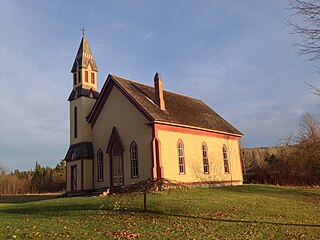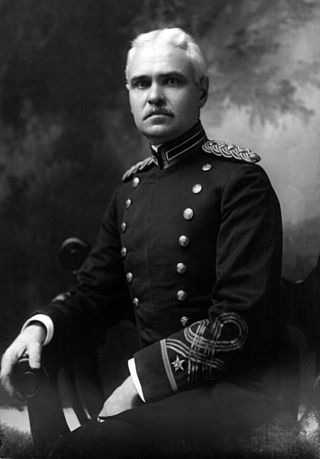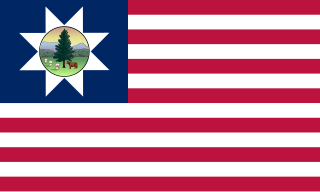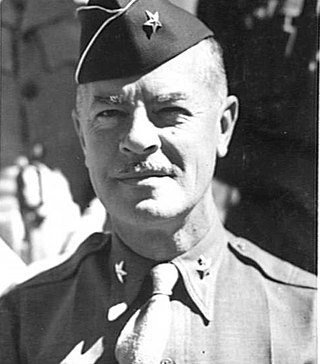
Stannard is a town in Caledonia County, Vermont. The population was 208 at the 2020 census. The town has no paved roads.

Glover is a town in Orleans County, Vermont, in the United States. As of the 2020 census, the town's population was 1,114. It contains two unincorporated villages, Glover and West Glover.

George Washington Goethals was a United States Army general and civil engineer, best known for his administration and supervision of the construction and the opening of the Panama Canal. He was the State Engineer of New Jersey and the Acting Quartermaster General of the United States Army.
Walter Gwynn was an American civil engineer and soldier who became a Virginia Provisional Army general and North Carolina militia brigadier general in the early days of the American Civil War in 1861 and subsequently a Confederate States Army colonel. He was a railroad engineer and railroad president before the Civil War, Florida Comptroller in 1863 and a civil engineer after the Civil War.

Chester Harding was Governor of the Panama Canal Zone from 1917 to 1921.

The 1st Vermont Infantry Regiment was a three months' infantry regiment in the Union Army during the American Civil War. It served in the eastern theater, in and around Fortress Monroe, Virginia.

Peter Thacher Washburn was a Vermont lawyer, politician and soldier. A veteran of the American Civil War, he served as the 31st governor of Vermont as a Republican from 1869 to 1870, and was the second Vermont Governor to die in office.

Charles Justin Bailey was a major general in the United States Army who commanded the 81st Infantry Division during World War I.

René Edward De Russy was an engineer, military educator, and career United States Army officer who was responsible for constructing many Eastern United States coastal fortifications, as well as some forts on the West Coast. He also served as superintendent of the United States Military Academy. He was promoted to brigadier general during the American Civil War.

Rebecca Stevens "Becky" Halstead is a former United States Army officer and the first female graduate of West Point to become a general officer. She was the 34th Chief of Ordnance and Commandant of the United States Army Ordnance Center and Schools at Aberdeen Proving Ground, Maryland.

Isaac William Littell was a United States Army brigadier general. He was awarded the Army Distinguished Service Medal for meritorious and distinguished service during World War I. Specifically, Littell was honored for building the camps and cantonments of the Army raised in the summer of 1917 as chief of the Cantonment Division of the Quartermaster General's Office.

Charles Albert Woodruff was a career officer in the United States Army. A veteran of the American Civil War, American Indian Wars, Spanish–American War, and Philippine–American War, he attained the rank of brigadier general before retiring in 1903.
John C. Sherburne was a Vermont attorney and judge. His career was most notable for his service as an associate justice of the Vermont Supreme Court from 1934 to 1949, and the court's Chief Justice from 1949 to 1955.

Brigadier General William Francis Heavey was a United States Army officer who commanded the 2nd Engineer Special Brigade in the South West Pacific Area during World War II. A West Point graduate, he entered the army engineers in 1917 and fought in World War I. He continued in the army during the 1920s and 1930s and was quickly promoted to brigadier general in 1942. After the war he became a consulting engineer and managed the Port of Houston.
Tiemann Newell Horn was a career officer in the United States Army. A veteran of World War I, he attained the rank of brigadier general.

William Sullivan Peirce was a United States Army officer in the late 19th and early 20th centuries. In World War I, he commanded the Springfield Armory. He attained the rank of brigadier general, and after the war served as the Army's Assistant Chief of Ordnance.

Henry W. Closson was a career officer in the United States Army. A veteran of the American Indian Wars and the American Civil War, he served from 1854 to 1896 and attained the rank of colonel. During the Civil War, Closson received brevet promotions to major and lieutenant colonel to recognize his heroism during the Siege of Port Hudson, Louisiana and Siege of Fort Morgan, Alabama.

John E. Woodward was a career officer in the United States Army. A veteran of the Spanish–American War, Philippine–American War, Moro Rebellion, Pancho Villa Expedition, and World War I, he served from 1892 to 1934 and attained the rank of brigadier general. Woodward was most notable for his command of the 113th Infantry Regiment, Camp Upton, 152d Depot Brigade, 24th Infantry Brigade, 151st Depot Brigade, and 12th Division.

Charles Keller was a United States Army Brigadier General and businessman.
















